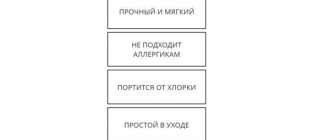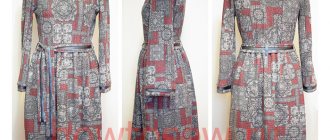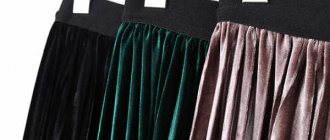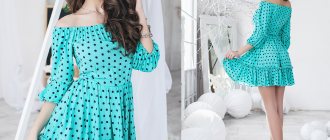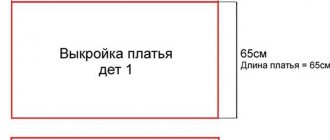A dress is one of the main elements of a woman's wardrobe. And the huge variety of cuts and fabrics only contributes to the fact that ladies can choose outfits according to their figure and characteristics. But, if a woman wants to shine with her elegance and luxury on a special day, then most likely she will prefer a floor-length dress. The maxi style can often be seen both at festive celebrations (graduation, wedding) and during daytime walks in the park.
Floor-length dresses are always in fashion in any weather, as they give a slim figure and emphasize its advantages. And you can create such an outfit with your own hands. If you are planning to sew yourself a dress, then the following information is just for you.
Preparation stage
Don’t worry if you haven’t sewed anything before, the main thing is to have the desire. All you have to do is follow the instructions carefully and you will succeed. Before we begin, let's prepare the necessary tools and materials:
- The fabric you plan to sew from. If this is a summer dress, then choose breathable and natural materials; during the cold season, look for the appropriate fabric. If the dress is being created for a special event, choose the fabric based on the event. To be more sure, check with the store salesperson;
- Sewing threads to match;
- Tape measure;
- Tailor's scissors (if you don't have these, we recommend purchasing them, since it will be difficult to do anything worthwhile when using simple stationery scissors);
- Decorative elements, if required (various fittings, ribbons, etc.);
- Ribbon or thin elastic band;
- Basic pattern, as well as paper or tracing paper;
- Tailor's chalk or soap, as well as safety pins;
- Sewing machine and overlocker, or zigzag attachment for overcasting edges.
For beginner needlewomen who are just trying their hand and want to add a new item to their wardrobe, we recommend using viscose knitwear. It is soft and pleasant to the touch, and most importantly, it is an easy material to process. For summer dresses, you can use chiffon, satin or cotton. But be careful, they don't hold their shape well.
Choice of pattern and style
Choosing a style and pattern is the main stage of the work that you will have to do yourself. The main thing is to decide on the model you want to create. The pattern you need can be found in specialized sewing magazines, such as Burda, or on the Internet. Copy all the details of the basic pattern onto paper or tracing paper, not forgetting about an allowance of about 1 cm! If this is your first time sewing, practice on models with loose silhouettes, as well as inexpensive and stretchy fabrics.
Transferring the pattern to fabric
After adjusting the pattern on tracing paper to your parameters, we determine its contours on the fabric. We use tailor's chalk or a piece of old soap, and secure the pattern with pins so that it does not move along the canvas. You need to translate starting with large fragments.
Taking measurements
In order to sew a dress according to your figure, you need to take measurements using a measuring tape. In order for the measurements to be accurate, you will need to hire an assistant. Required measurements:
- Length of the product;
- Waist and hip circumference;
- Chest circumference at the protruding point;
- Neck circumference;
- Length from neck to waist (back shelf);
- Shoulder width.
DIY winter dress to the floor
Long dresses reaching to the floor are an integral part of social parties and red carpets, however, their popularity does not stop there. Similar outfits can often be seen on women going to corporate events, birthdays, visiting friends or on a date. Nowadays, long dresses are increasingly used as casual wear. It doesn’t have to be expensive, the main thing is that the outfit should fit well. To ensure that your dress is exclusive and you look simply irresistible in it, you should read the instructions on how to sew a floor-length dress with your own hands.
Before you find out how to sew a floor-length dress, you should think about which option suits and pleases you best. A long, straight dress will make you look slimmer, but a model that is too tight will not work if you are somewhat curvy. In this case, it is better to choose styles that go from the chest or have a loose cut and do not hug the figure.
All DIY floor-length dresses can be divided into the following types:
- A-silhouette. The style of the dress evenly widens towards the bottom with a tight-fitting bodice. The shape resembles the letter A. Most often, such models are one-piece.
- Ballroom dresses are the most luxurious dresses, with an open back and shoulders, with a fluffy long skirt reaching to the floor. They are made from expensive, beautiful fabrics and decorated with exquisite trimmings - lace, drapery, beads, rhinestones, ruffles and embroidery.
- The evening version is intended for special occasions, therefore it is made from expensive fabrics using trim. As a rule, it is floor-length, has a deep neckline and is characterized by the absence of sleeves.
- Empire style dresses have deep necklines and high waists. The skirt comes from the belt, forming many folds. The drapery is a very nice detail of this model.
- A caftan dress is a long, flowing garment made from linen or silk. Very often performed with straps.
- A sheath dress is a narrow dress, often without sleeves or a collar. It has no seam at the waist and is a cocktail, evening or casual wear option.
- Almost every girl has a sundress with straps in her wardrobe. Its floor-length variation is indispensable for hot summer days.
- Do-it-yourself floor-length dresses in a rustic style are always distinguished by colorful, rich motifs and fantasy prints. Stylish country dresses also have soft lace inserts. They are the ones that evoke thoughts of outdoor recreation, so romantic and long-awaited.
As we have already said, before sewing a long floor-length dress with your own hands, you should decide for what occasions you are going to use it. This also has its own nuances and accents:
- It is better to make a floor-length dress with your own hands for the office from durable, dense fabrics, such as suit or dress fabric. After all, you plan to wear such an outfit every day and it will require constant washing, which the fabric should easily tolerate.
- A dress for summer walks can be sewn from light natural materials. Cotton or linen are suitable, it looks especially impressive with lace, various chiffons and crepes, as well as crinkled fabric. The floral pattern is perfect for this style.
- For an evening dress, you can safely choose various complex fabrics - with sparkles, sequins, and the addition of metallic threads. You will wear it on special occasions, so it has the right to be impractical.
- If you have chosen a style of clothing with various folds, draperies, pockets, and braid decor, then you should know that these details will look great on a DIY floor-length dress made of a plain fabric.
Also, when deciding how to sew a long dress, do not forget that different prints on fabrics can give completely different visual perceptions, and not always to the benefit of the owner of the outfit:
- Fabrics with a voluminous texture - bouclé, tweed - can ruin fragile figures, not to mention curvy figures, so you need to choose materials of medium density.
- Satin, metallic, shiny, leather materials are suitable for thin girls and ladies - they visually add and round out the shape.
- On the contrary, these fabrics are contraindicated for those with curvy figures. And also lycra and thin knitwear. It is too tight on the figure and emphasizes imperfections.
- Miniature people should also not buy materials with large patterns - this will distort the proportions of the figure.
Even a novice needlewoman can sew a floor-length dress with her own hands; the main thing is to strictly follow the recommendations. Below is a list of required materials and tools:
- fabric;
- a set of sewing threads;
- tailor's scissors;
- safety pins;
- centimeter;
- iron;
- decorative elements (fittings, ribbons);
- basic pattern.
Important! Of course, you can’t do without a sewing machine and an overlocker or the zigzag stitch function on a regular sewing machine for overcasting the edges of the fabric. And don’t forget to take the basic measurements that you will need in order to sew a floor-length dress with your own hands.
To answer the question of how to sew a long floor-length dress with your own hands, let's look at one of the simplest options - a high-waisted style. This outfit is perfect for plump girls, and will also become indispensable for pregnant women. So, let's look at creating such a dress step by step:
- In order to make a pattern, we will need your individual measurements. Better yet, use a basic pattern that you can download on the Internet as a basis.
- Now divide the shelf in half so that a connecting line can be drawn from the top point of the dart above the chest.
- Cut the paper along this line, connect the resulting halves with glue or tape.
- Round the open area along the neckline according to the pattern.
- From the bottom point of the armhole, set aside 10 centimeters along the side seam.
- Draw a horizontal line to it and cut the front part. The front side of the top of the dress is transferred to a separate pattern piece.
- Cut the pattern along the dotted lines that correspond to the folds and seams.
- To increase the number of folds, add allowances.
- Sew a hidden zipper in the middle of the back or on the side. At the bottom of the dress for the hem, make an allowance of 3 - 4 cm, and at the seams 1 cm will be enough.
- First, sweep all the parts by hand and only then perform all operations on a sewing machine and overlocker.
Important! Don't forget to remove the basting when finished sewing. We sweep away all the details, and only after that do the machine stitching.
If you are thinking about how to quickly sew a floor-length dress with your own hands without a pattern, then we offer the following option for a light summer dress. It has a huge advantage - all the contours can be applied directly to the fabric, because it is quite simple. This can be done in just 10-15 minutes. So:
- Draw a rectangle, the height of which will be equal to the length of your dress, and the width will be equal to the volume of your hips plus 10-20 centimeters for freedom of fit. You will need 2 such parts - a shelf and a back.
- The top of the rectangles is slightly narrowed at the edges. The line begins to change its position from the bottom point of the armhole.
You also need to make two thin belts from the main fabric, no more than 2 cm wide. One of them will be the belt of our future floor-length dress with your own hands, the second will be a drawstring for the neckline. Then we perform the following operations:
- First you need to sew the side seams using an overlocker.
- Cut along the center front to the cut mark, fold with a very narrow hem and sew with a machine.
- Overlock the armhole line - both back and front. Fold the edge inward 1 cm and sew with a regular seam.
- Now process the neckline on both parts in the same way. First, the edge of the fabric is passed on the overlocker, then you need to make a hem, but a little more - 2 cm, and sew a line.
- Insert one of the belts into the resulting drawstring along the neckline.
- Decorate the bottom of the dress by pre-processing the edge of the fabric on an overlocker or making a double hem.
DIY long dress is ready. If desired, you can add lace or braid to the bottom of the hem.
A hand-made floor-length dress made from flowing light fabric looks luxurious. To ensure that the bottom falls beautifully and there are no folds at the waist, the model is made with a semi-sun skirt. Making a pattern for such a model is quite simple. Let's look at this using a specific example, using a waist circumference of 74 cm as a basis:
- The first step to constructing a skirt is to fold the fabric so that you get a square with a side of one and a half meters.
- The fabric should be laid out on the floor and a drawing made directly on it with chalk or soap. The square should be positioned so that the fold is on the right side and the edge is on top. Now you can start building the drawing.
- In the upper right corner you need to put a small dot and draw a straight line from it along the edge to the very end.
- Along this straight line from the point you need to set aside 24 cm and put another point. This figure was obtained after multiplying the half-waist circumference by the coefficient for this skirt shape, which is 0.64. Let the first point be point O, and the second, say, point B.
- Next, you need to plot the desired length of the skirt from point B along the drawn line. This will be point C. In this example, this value is 110 cm.
- After this, you should use an improvised compass: holding a centimeter tape at point O with one hand and measuring the required distance, draw an arc first from point B to a new point M, and then from C to K.
- The arc VM will be equal to the half-circumference of the waist, and the length of the arc SC is determined by the position of point K: it must be on a straight line passing through points O and M.
- In order to sew the top part of a floor-length dress with your own hands, you need to cut out all the details from the remaining fabric, according to the pattern.
- First you need to sew the skirt along the side seams. Then join the shoulder and side seams and finish the neckline. This can be done with binding, or you can sew on a facing duplicated with non-woven fabric.
- Then sew in the sleeves and connect the top and bottom of the dress, matching the side seams.
- Now all that remains is to insert the zipper, fold the edges of the sleeves and skirt, and the floor-length dress is ready with your own hands.
A long DIY dress made from materials such as chiffon or crepe will add romance to any look. The fabric is suitable either plain, which can be made in several layers, or in any floral pattern. Sewing a floor-length dress with your own hands according to the following pattern will be quite simple:
- Take any of your sleeveless tops and transfer its outlines onto thick paper.
- Fold a sheet of paper in half and check for symmetry.
- Then draw the line of the side seams to the length you need. Draw the line diagonally from the end line of the armhole. This way you will get a floor-length A-line dress with your own hands.
- Now transfer the resulting details onto the fabric. Don't forget to add seam allowances.
- Finish the neck line and armhole with bias tape or braid.
Thus, you can easily and simply design a long dress with your own hands, which can be worn with or without a thin belt.
Chiffon, like crepe, is a delicate material that requires careful handling. Let's look at some features of sewing chiffon products:
- When cutting the material, it is necessary to use a backing material, as the fabric is very slippery.
- If we don’t want to ruin the fabric, we attach the pattern only with very sharp pins.
- If we use special fabric glue in the form of a spray instead of pins, then we place the patterns on the cut strictly along the grain thread, press the middle with a weight, treat the edges with glue, and after a couple of minutes press it tightly to the fabric.
- When working with chiffon, it is forbidden to use a copy wheel - it can leave unsightly marks on the fabric.
- Mark lines, darts and folds using thin threads and a thin needle, running stitches no more than 2 mm long.
- Chiffon should be ironed through a gauze cloth and only with a dry iron to avoid the formation of wrinkles on the fabric.
Another great option for a floor-length dress with your own hands is a transforming model. To sew it, you will need elastic fabric 150 cm wide and a pattern:
- Measure the circumference of your chest with a centimeter, and then measure the circumference in several places - depending on what style you will turn the dress into, there will be a belt there. The height of the belt should be approximately 15 cm.
- If you want a floor-length dress with your own hands, measure the distance from the collarbone to the length you want.
- When cutting your fabric, be sure to add seam and hem allowances.
Now let’s move on directly to the process of sewing a floor-length dress with your own hands:
- To sew the ties, cut strips 3 cm wide from the finished fabric. Sew one strip to the other to form a long strip 2-3 meters long. Fold the strip inside out, stitch, overlock the edge and turn right side out.
- To make the belt, cut a rectangle 30 cm high and the length you have determined to fit the belt. Fold lengthwise, overlock, turn inside out and sew into a ring.
- Fold the remaining fabric along the longest side and cut the fabric at the fold to the length of half the waistband. Make a cut for sewing in the belt. Finish the edges with an overlocker and create a back seam. Sew the belt into the hole prepared for it and finish it with an overlocker.
- Then finish the long edges of the fabric. On the remaining untreated side of the fabric, make a skirt drawstring 2-3 cm wide. Thread the prepared ties into the drawstring and enjoy the original dress sewn with your own hands.
The dress is known as a basic attribute of a woman's wardrobe. In the modern fashion industry, it is no longer an element of exclusively evening events, but is found both at shows and in everyday life: in the office, on a walk and even at home.
New design solutions make the model universal and comfortable, allowing you to wear it regardless of the season. Airy materials provide a cool feeling in summer, while thicker fabrics provide thermoregulation in winter. This option is ideal for replacing boring and sometimes bulky trousers or jeans and boring skirts. In combination with warm tights or leggings you will not be cold even in frosty weather.
A floor-length dress always remains at the peak of fashion, favorably emphasizing all the advantages of the figure and visually elongating the silhouette. Thanks to the versatility, practicality and aesthetic features of the style, many are interested in how to sew a maxi-length dress on their own. By following the advice of experienced seamstresses and following step-by-step instructions, you can sew a floor-length dress with your own hands in just a few hours.
A floor-length dress is not the easiest piece of clothing to sew and then combine. In addition to the fact that it requires high-quality stitching, the product must fit perfectly, hide flaws and emphasize advantages. To do this, you need to decide on the style of the future dress.
It is necessary to take into account all the nuances of the physique before selecting a pattern and material. You can get an outside opinion: ask someone to give advice on choosing a model and fabric. A fresh look will allow you to more accurately choose a style and transform your everyday appearance.
It is also worth determining your body type (“pear”, “inverted triangle”, “apple”, “rectangle”, “hourglass”) and build on it. Tall girls with an asthenic physique can choose a fitted, floor-length dress with drapery or a peplum at the waist. For complete ones, it’s better to stick to straight or A-shaped options. If you have a pear-type body type, then you can safely afford any trim in the shoulder area to balance your figure.
Ideally, you need to sew dresses from expensive, natural fabrics, especially if you are planning to create a formal evening version. The fabric can be either monochrome or printed - it all depends on preference. Abstraction or large flowers will help hide excess weight, and plain products in light colors will add volume. The density and elasticity of the fabric depends on the season and area of use. Long dresses can be quite difficult to walk in, so first create slits or choose stretchy fabric that does not restrict your gait.
Beginners should consider knitted fabrics or fabrics with stretch fibers. Experienced seamstresses afford thicker and more expensive fabrics - jacquard, silk, poplin, denim.
Sewing a long dress that fits beautifully is not that difficult. It is enough to follow a certain rule. Always pay attention to the direction of stretching of the fabric if you want to maintain the stretch properties of the fabric for comfortable wear.
The edges of the fabric should be processed using an overlocker or zigzag stitch on a regular sewing machine (even if it is knitwear). This is necessary so that the threads at the edges do not unravel and the fabric does not curl during sewing.
Modeling a floor-length dress pattern can be a difficult step for beginning seamstresses. Nuances and special knowledge sometimes only confuse, so first use a ready-made sample. You just need to print it and adjust it to your parameters. A lot of patterns are now available on the Internet, often corresponding to the required measurements.
- Length of the product.
- Length of the back shelf (from neck to waist level).
- Waist circumference.
- Hip girth.
- Chest circumference at the most protruding point.
- Neck circumference.
- Shoulder width.
You can do without a pattern, especially if you are creating a straight dress for everyday or home wear. To do this, simply trace the outline of the old product on paper, and transfer the resulting drawing to the canvas. You can also use a T-shirt or tunic, and then lengthen the drawing to the ankles or toes.
After adjusting the drawing, it is transferred to the canvas using chalk, a bar of soap or a special, washable marker for fabrics. Always start cutting with large pieces. Use a flat, spacious surface to visually analyze proportions. For reliability, attach the parts to the material with needles or pins.
A high-waisted or drawstring model is great for plus-size and pregnant women. How to sew a long dress in this version in just a couple of hours - you only need a set of special tools and suitable material.
- About 2 m of knitted fabric.
- 0.5 m of knit in a different shade to finish the edges (optional, but you can use this technique to add contrast).
- Drawstring fabric (about 1 m long).
- Thin elastic band or ribbon (about 2 cm).
- Pattern.
- French pins.
- Iron.
- Scissors.
- Sewing machine.
- Cut out the details of the dress according to the pattern and cut them out from the purchased fabric. Don't forget about 1 cm seam allowance. Cut out a strip for the drawstring taking into account the location of the ribbon bow.
- You should end up with two main fragments of the main fabric (front and back) with a strip for the drawstring made of a plain material to match the color of the dress.
- Create a simple neckline on the front half. It can be duplicated on the back. If you have a large bust and shoulder area, then it is better to choose a V-neck to lengthen the silhouette and emphasize the bust.
- Use French pins to connect the two pieces at the shoulder and side seams. Sew the shoulders first and then the sides. A small sleeve may form, which will make the shoulders appear smoother. If you planned a product without sleeves at all, at this stage cut off the excess fabric and only after that go along the armholes with a hem or bias tape.
- Process the neck. It is better to make all seams with a zigzag stitch so that they stretch well and last longer.
- Once the base is sewn and finished, move on to the drawstring. Form a thin strip of fabric with folded edges (the hem is done using an iron).
- Place the drawstring at the waist on the right side, secure with pins and stitch. Start stitching from the end, gradually moving towards the opposite edge. You can sew the drawstring from the wrong side and make holes for the ropes, but in this version it is an original addition to the style, so it is sewn from the face.
- Insert the braid or string into the drawstring and tie the edges (or machine stitch) so that the fabric does not rip apart.
- Remove excess threads, trim the edges of the seams with an overlocker or curly scissors and try on the product.
Taking into account the tips from the previous instructions, it will not be difficult to create an even lighter version of the dress from flying material. It does not require a pattern at all, and it is formed in three steps.
- Sew a wide piece of material (2m x 2m depending on height) using one side seam.
- Secure the elastic at the waist and sew it with a straight stitch.
- Finish the open bottom edge with a hem stitch.
This product can be worn as a dress, if you wear it higher, or as a skirt, if you twist the elastic several layers inside. The option is ideal for summer, beach wear.
We sew a floor-length dress with a high waist or drawstring
The style of a long dress to the toes with a drawstring or high waist is perfect for any girl, even pregnant women.
To sew this outfit, 2-3 hours of work is enough. You should know: a drawstring is a folded or stitched strip of fabric that forms a kind of “gutter”.
A cord or elastic band is pulled into it. Progress
The sewing process for this dress is as follows:
- We cut out the previously created pattern using tailor's scissors along the allowance lines. We also cut out a strip for the drawstring. At the same time, we take into account that you will need to leave space for the ribbon bow;
- As a result, you should have front and back fragments of fabric, as well as a strip for the drawstring;
- Form a neckline on the front of the workpiece. If necessary, do the same on the back fragment. If you have a large bust and shoulder area, it is best to choose a V-shape. This will only emphasize your luxurious breasts and lengthen the silhouette of your figure;
- Use pins to fasten the 2 fragments together in the area of the side and shoulder seams. First we sew the shoulders, then the sides. If a small sleeve has formed, it will only make the shoulders more graceful. But if you don’t want sleeves on the dress, cut off the unnecessary fabric and use bias tape to go along the armholes;
- Then you need to work the neckline with a zigzag stitch. This is necessary so that the seams can stretch and their service life increases;
- After the main part has been processed and sewn, you need to move on to the drawstring. Gather a thin strip of fabric and use an iron to make folded edges;
- Place the drawstring on the front side at the waist and secure it with pins. Then stitch from end to opposite edge. There is another option for adapting the drawstring - sew it on the inside out and make holes for the ropes. But, if you want it to complement the dress, then use the first option;
- Insert a thin rope or drawstring into the drawstring, then tie or stitch the edges. This is necessary so that the fabric does not begin to diverge;
- Using an overlocker or curly scissors, trim the edges, then get rid of excess threads;
- Try on your dress.
Floor-length dress in the form of a skirt without a pattern
We'll tell you about creating another model of a floor-length dress, which can be done not in a couple of hours, but in just 30 minutes! A floor dress in the form of a skirt is sewn very easily and in a short time, and the main advantage of this style is that it does not require any pattern. For manufacturing, it is best to use flying and lightweight material.
The work process consists of 3 steps:
- Use one side seam to sew a wide piece of material (2 by 2 meters, depending on your height);
- Attach the elastic band at the waist and sew it to the fabric with a straight stitch;
- Finish the bottom open edge with a hem stitch;
- Try on the created dress.
A floor-length dress can make any girl more sophisticated and gentle. A model created with your own hands will be an excellent investment. And who knows, maybe your friends, delighted with the unique outfit, will ask for the services of a seamstress. And life can completely change, and you will create your own clothing collection.
Dress with a stand-up collar.
Using the basic base of the dress, remodel the dart to the convexity of the shoulder blades and reduce the opening of the chest dart by 2 cm (Fig. 1).
Extend the shoulder line by 3 cm and draw it slightly rounded.
Deepen the front and back armholes by 3 cm. Draw a new armhole line.
Draw the side lines of the front and back of the dress, fitting the details by 5 cm.
Move the opening of the chest dart to the side line and shorten the dart.
Dress modeling and sleeve construction.
Draw a line for the model neck, as shown in the drawing (Fig. 2). Draw a curly line for a decorative seam on the front and back.
To construct a sleeve, draw two mutually perpendicular lines and attach the front and back of the dress to them so that the shoulder lines align at the vertical line (Fig. 3).
Measure the length of the armhole. Draw a flat line for the sleeve cap with a length equal to the length of the armhole, as shown in the drawing.
Draw out the lines of the longitudinal sections of the sleeve (sleeve length - three quarters), slightly narrowing it downwards.
Bottom of dress and collar.
Separate the top front and back pieces from the bottom pieces.
Cut the lower parts of the front and back lengthwise and separate the sections along the bottom by 10 cm each (Fig. 4).
Mark the location of the zipper in the middle of the back.
Draw a stand-up collar according to the measured length of the front and back neck.
Bright colorful embroidery, made in the national style, can easily decorate any item of clothing. Embroidery looks especially expressive and colorful on dresses. Embroidered dresses are a wonderful outfit for special occasions, and they are also suitable for everyday wear. This outfit will give its owner a special charm and a sense of uniqueness.

